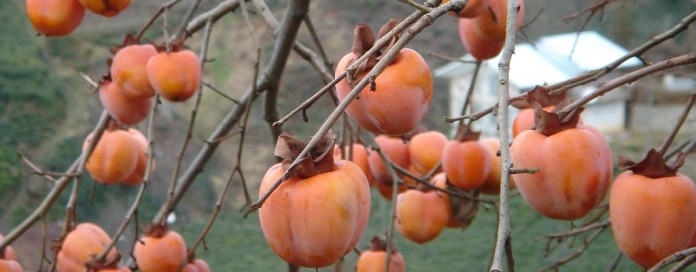Green, inedible fruits become obvious on female American persimmon trees in September. It is not until late fall that it ripens and turns from green to yellow to deep orange.
Although it’s not time to harvest persimmon fruit, it’s a good time to start looking for it because ripe fruits don’t last long in the wild. Persimmons are sought after by pileated woodpeckers, robins, bluebirds, cedar waxwings, opossums, skunks, foxes and even coyotes. In fact, passing through an animal’s digestive system helps the seeds germinate in the spring.
Learn how to find and identify American persimmon trees, when to harvest their fruit and how to enjoy your bounty.
Finding and identifying American persimmon trees
American persimmon trees can be found throughout the lower Midwest and Southeast of the Unided States. They grow in moist, well-drained locations, including river bottoms, stream banks and mixed-wood and hardwood forests. They are shade-tolerent trees, but produce more fruit in the sun.
American persimmon trees can reach 50 feet tall, but are typically much shorter. Persimmon trees feature dark grey bark that is deeply furrowed and plated. Its leaves grow alternately on 1-inch stemlets. They are oval, 3-4 inches long, with smooth edges and a slight fold along the midvein. Persimmon fruits are hard and green throughout summer – most easily noticed in September – and deep orange with soft flesh and wrinkled skin when they are ripe mid to late in the fall.
Harvesting American persimmon fruits
Once you’ve located some wild American persimmon trees to harvest fruit from, check them periodically to document the ripeness of the fruit. You won’t find ripe persimmon fruits until after there have been a few hard frosts; however, you don’t want to wait for the local wildlife to have their turn first.
The ripest fruit will fall from the tree and be easily collected from the ground, so make sure to check there even if the fruit on the tree is not quite ripe. Other ripe fruits will be easily removed or fall easily to the ground when the tree or branch is shaken. Fruits that are tightly attached to the twigs of the tree are still unripe.
Don’t collect unripe fruit as it has an astringent taste that will cause your mouth to pucker and dry out. Similarly, avoid fruit with insect damage or broken skin.
Eating persimmon fruits
Persimmon puree. Making persimmon puree is one way to consume the fruit. It can be added to smoothies; eaten on top of cheese, ice cream or yogurt or used to make fruit breads, teacakes, scones and fruit bars.
Dried persimmon. can be dried in a dehydrator to eat as is or sliced and used in granola or baked goods.
Cooked Persimmon. You might also consider cooking down freshly chopped persimmon with sugar, vinegar and chili spices to make a chutney base that can be used with other fruit to make a salsa.
Future harvests
If you find you like the flavor of the American persimmon, you may want to propagate and plant some persimmons to ensure future harvests.
- Collect the seeds from ripe fruits.
- Remove the pulp.
- Air dry for two days.
- Sow seeds in half-inch deep in a rich soil bed and mulch for winter.

















Nice read about the persimmon but you could have included an actual photograph so we know what the heck kind of tree we’re looking at. I love the fruit but I have no idea what the tree looks like. ✌🏽🌿
Have a bunch of em here in central Ohio. Can’t remember how they started growing here. Pretty sure Grandpa told me once, but – well, you know how it goes. I personally can’t stand em, mainly due to the texture. The other factor is that I’m allergic to fruit.
For several years (about 60) we’ve had persimmon trees, but it’s only been in the last 15 years that they’ve finally been fertilized. Turns out, a neighbor had one on his property. Natural growth, meaning seed deposited by a bird, most likely. Now we’re getting a bunch of new persimmon trees each year…with me transplanting the sproutlings wherever I can on the property.
Ducks and geese love the fruit. Chickens eat em to some extent. Picking away at em for the most part. We usually wait for the first real good frost to harvest em. Not a light frost, but one where in the morning the grass crunches and there’s a frosty sheen on everything.
Unfertilized persimmons are a lil bit bigger than a quarter, length wise. Ducks will gobble those things whole like a starving man possessed, lol.
Fertilized, they are more or less about the size of a pawpaw fruit. And yes, we grow pawpaw as well.
We’ve had really harsh winters, but the persimmon trees persist. I was always told that they shouldn’t even be able to grow in my part of Ohio, but…. lol
That’s really cool. I never realized Ohio had so many native fruit trees until later in life because they don’t grow in northeast Ohio. Thanks for sharing!